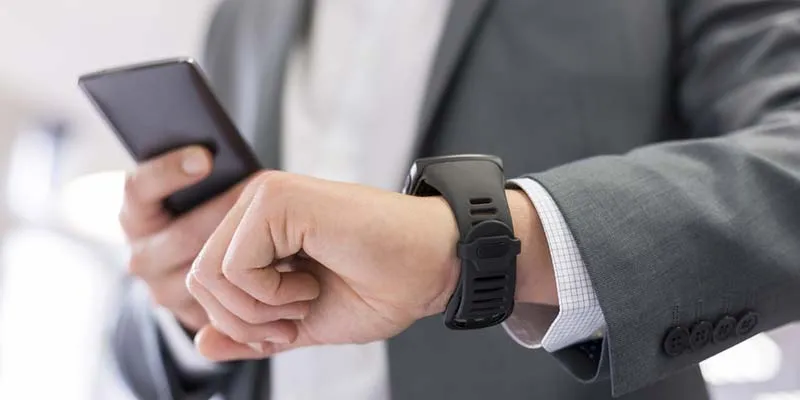Wearable technology poised to surge: things all CEOs & CIOs must know
Even when our fixture with smartphones as the ‘all-controlling’ hub continues to gather steam, there is yet another revolution ready to shake things up. Wearable devices, tagged for long as the “next big thing” has truly arrived and in a big way.
Here are some astonishing numbers that would just enable us to size things up: According to a research conducted by PwC’s Consumer Intelligence Series that surveyed 1000 American consumers, tech influencers and business executives, 20% of the adults in the US already own a wearable device. An adoption rate which is on par with that of the adoption rate of tablets in 2012.

In India too, the market for wearable devices could touch a whopping 200 million within the next three years. This is an unprecedented increase considering that the wearable device market in India was pegged at just a measly Rs 25 crores in 2014. Indian consumers also rank among the world’s most willing paid users of wearable devices. In fact, fitness bands and smart watches are already becoming the most visible form of wearables among the Indian consumer segment. Wearable glasses are soon emerging as the other most sought after wearable device, especially in the enterprise arena.
The business of wearables
While the focus lies on consumer wearable technology, it is the more complex enterprise sphere where wearable technology can truly emerge as the driving force. For example, imagine if truck drivers are provided with wearable glasses that are equipped with accurate satellite navigation along with traffic updates on their route, all information displayed right in front of them. A huge benefit for the drivers who can save on precious time, be more productive and hence enhance overall profitability for the enterprise.
Wearables can even be used in the retail domain to an amazing effect. Just like online stores that display products based on consumer purchase behaviour and history, store owners can effectively use CRM-powered augmented reality glasses embedded with facial recognition software. This will allow store owners to instantly recognize privileged or high-value customers along with their complete purchase history and preferences thereby driving customer service strategies to a completely new level.
This and several such advanced yet simple-to-use business applications are just where the future of wearables in the enterprise spectrum lies. Already, areas like manufacturing, infrastructure, heavy engineering, oil & gas, mining and defence are taking concrete steps to effectively merge wearable technology and solutions to enterprise modules and ecosystems to further their objectives of efficiency, productivity, safety and security.
The pre-requisites
While the stage seems set for wearable technology to become a regular and significant element in the enterprise scheme of things, there are some key pre-requisites that need to be managed before assimilating wearable technology into a complex enterprise ecosystem:
Seamless Integration:
To think that wearable technology can be a stand-alone choice above other devices and technologies seems to be a far-fetched idea, at least for now. Hence, it is critical for wearable devices to integrate with existing devices & technologies like smartphones, tablets, notebooks, laptops and other mobile devices. Alternately, integration with aftermarket custom ROMs like Mobiliya KratOS can further boost the wearables with critical features like secure transactions, secure messaging, encryption and manageability.
However, this can be a daunting task considering that the new solution must deliver the same or better ease of use and flexibility to manage data and resources.
User-Centric:
Like in the case of all breakthrough technologies, it needs to be simple to succeed. Wearable devices must be designed around the end user and tailored to deliver a robust and simple user interface and experience to truly make these devices usable. Plus, these devices must be equipped with the ability to process, segregate and refine data to deliver the most precise and relevant actionable insights. Yet another key factor is the cost. The price point must be practical enough for buyers to truly consider wearables as a norm and a regular in the overall scheme of things.
Enterprise-Owned Module:
Companies looking to adopt wearable technology would essentially need to work on the COPE (Corporate Owned Personally Enabled) pattern. This is in lieu of the highly specialised requirements, the need to sync with other devices seamlessly and the cost. Thus, the onus would lie on enterprise IT teams and CIOs to design the right framework that would connect with the existing IT policies and restrictions while adopting to the wearable technology.
The roadmap ahead
Considering the specialised hardware and software requirements of an enterprise, the strategy would be to opt for an end-to-end wearable technology architecture that delivers on both these fronts. Already, the domain is witnessing a surge of futuristic and innovative enterprise-specific wearables that include exoskeletons by Fortis & 1MM Corp, voice activated communication devices by Theatro and wearable “smartglasses” by Mobiliya Technologies. Oculus Rift with its virtual reality device will allow gamers to step inside the virtual gaming world, a dream for all gaming enthusiasts.
The use of wearables is also set to be a part of space research. NASA has tied up with Microsoft for developing an amazing software that will allow NASA scientists to work on Mars using wearable technology. Named as OnSight, this will allow scientists to walk on Mars to research and explore even as they sit in their office. Wearable technology will enable scientists get an unparalleled view and perspective of Mars, who till now only had to depend on computer imagery.
These are just a few examples that show that wearables in rapidly becoming a great alternative for enterprises to explore new frontiers. The next couple of years could be pivotal and it would be interesting to wait and watch how things unfold from here.
About the author:
KrishKupathil, CEO, Mobiliya, brings to the table a vast experience of more than 25 years spanning technology, strategy and business.







